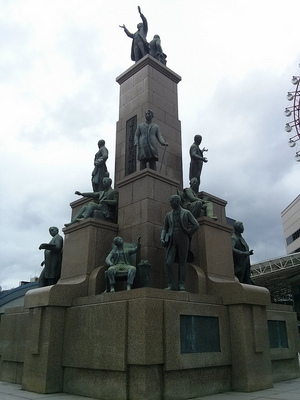Difference between revisions of "Satsuma students"
| Line 5: | Line 5: | ||
The students, aided by the Scotsman [[Thomas Glover]], claimed to be merely traveling to the [[Koshiki Islands]] just off the coast of Kyushu, when they departed from Hashima (an area in Kushikino city, on the Kyushu mainland<!--串木野 羽島-->). In fact, they left Japan entirely, arriving in Singapore twenty days later; 46 days after that, they arrived in London. All adopted new names while overseas, but most are known today by their "real" names. | The students, aided by the Scotsman [[Thomas Glover]], claimed to be merely traveling to the [[Koshiki Islands]] just off the coast of Kyushu, when they departed from Hashima (an area in Kushikino city, on the Kyushu mainland<!--串木野 羽島-->). In fact, they left Japan entirely, arriving in Singapore twenty days later; 46 days after that, they arrived in London. All adopted new names while overseas, but most are known today by their "real" names. | ||
| + | |||
| + | The mission was led by 34-year-old [[Niiro Hisanobu]] and 31-year-old [[Godai Tomoatsu]], and included a set of three brothers: 28-year-old [[Machida Hisanari]], 19-year-old [[Machida Sanetsumi]], and 15-year-old [[Machida Seijiro|Machida Seijirô]]. | ||
The students returned to Japan with examples of numerous new technologies, including spinning machines, and also made arrangements for Satsuma to show a pavilion, separate from that of the shogunate, at the [[1867 Paris World's Fair]]. Members of the mission also arranged to gain Britain's support for Satsuma in the upcoming [[Meiji Restoration|rebellion against the shogunate]]. | The students returned to Japan with examples of numerous new technologies, including spinning machines, and also made arrangements for Satsuma to show a pavilion, separate from that of the shogunate, at the [[1867 Paris World's Fair]]. Members of the mission also arranged to gain Britain's support for Satsuma in the upcoming [[Meiji Restoration|rebellion against the shogunate]]. | ||
| Line 16: | Line 18: | ||
*[[Machida Hisanari]] (28) - first director of [[Tokyo National Museum]] | *[[Machida Hisanari]] (28) - first director of [[Tokyo National Museum]] | ||
*[[Machida Sanetsumi]] (19) | *[[Machida Sanetsumi]] (19) | ||
| + | *[[Machida Seijiro|Machida Seijirô]] (15) | ||
*[[Matsuki Koan|Matsuki Kôan]] (34)(aka Terashima Munenori) | *[[Matsuki Koan|Matsuki Kôan]] (34)(aka Terashima Munenori) | ||
*[[Mori Arinori]] (19) - first [[Ministry of Education|Minister of Education]] | *[[Mori Arinori]] (19) - first [[Ministry of Education|Minister of Education]] | ||
Revision as of 01:17, 26 October 2015
- Traveled: 1865
Nineteen young men from Satsuma han were among the first Japanese to study overseas in the West, departing Japan in 1865, a year before the Tokugawa shogunate lifted bans on overseas travel. A number of these students went on to become prominent figures in the Meiji government, or in Meiji period society otherwise.
The students, aided by the Scotsman Thomas Glover, claimed to be merely traveling to the Koshiki Islands just off the coast of Kyushu, when they departed from Hashima (an area in Kushikino city, on the Kyushu mainland). In fact, they left Japan entirely, arriving in Singapore twenty days later; 46 days after that, they arrived in London. All adopted new names while overseas, but most are known today by their "real" names.
The mission was led by 34-year-old Niiro Hisanobu and 31-year-old Godai Tomoatsu, and included a set of three brothers: 28-year-old Machida Hisanari, 19-year-old Machida Sanetsumi, and 15-year-old Machida Seijirô.
The students returned to Japan with examples of numerous new technologies, including spinning machines, and also made arrangements for Satsuma to show a pavilion, separate from that of the shogunate, at the 1867 Paris World's Fair. Members of the mission also arranged to gain Britain's support for Satsuma in the upcoming rebellion against the shogunate.
Members of the Mission
(listed along with age at the time of the mission, and later historical significance)
- Niiro Hisanobu (34) - leader of the mission
- Godai Tomoatsu (31)
- Hatakeyama Yoshinari (23) - first president of University of Tokyo
- Ichiki Kazuhiko (24) - first Japanese to graduate from Annapolis
- Machida Hisanari (28) - first director of Tokyo National Museum
- Machida Sanetsumi (19)
- Machida Seijirô (15)
- Matsuki Kôan (34)(aka Terashima Munenori)
- Mori Arinori (19) - first Minister of Education
- Murahashi Naoe (23)
- Nagasawa Kanae (13) - settled in US, started a vineyard
- Nagoe Tokinari (21)
- Nakamura Hironari (25) - ambassador to the Netherlands, Portugal, and Denmark
- Samejima Hisanobu (21) - ambassador to France
- Tanaka Moriaki (23)
- Tôgô Ainoshin (23)
- Yoshida Kiyonari (21) - ambassador to the United States
References
- Plaque at Kagoshima-Chûô train station, Kagoshima City.[1]
